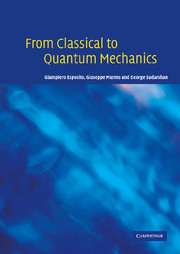Book contents
- Frontmatter
- Contents
- Preface
- Acknowledgments
- Part I From classical to wave mechanics
- Part II Weyl quantization and algebraic methods
- Part III Selected topics
- 14 From classical to quantum statistical mechanics
- 15 Lagrangian and phase-space formulations
- 16 Dirac equation and no-interaction theorem
- References
- Index
16 - Dirac equation and no-interaction theorem
Published online by Cambridge University Press: 14 January 2010
- Frontmatter
- Contents
- Preface
- Acknowledgments
- Part I From classical to wave mechanics
- Part II Weyl quantization and algebraic methods
- Part III Selected topics
- 14 From classical to quantum statistical mechanics
- 15 Lagrangian and phase-space formulations
- 16 Dirac equation and no-interaction theorem
- References
- Index
Summary
The requirement of relativistic invariance is first used to derive the Dirac wave equation for the electron, with the associated γ-matrix formalism.
Relativistic invariance may indeed involve two different theoretical postulates: symmetry of the theory under the relativistic transformation group, and explicit transformation properties or manifest invariance of certain quantities. For a classical mechanical theory of a fixed number of particles, the Lorentz transformation formula can be assumed for the coordinates of the space-time events that comprise the world lines of the particles as defined by their positions as a function of time. The assumption of manifest invariance is expressed in terms of equations involving the Poisson brackets of the canonical position coordinates with the generators of the Lorentz group. For a theory of two particles, the only generators satisfying these latter equations jointly with the Poisson-bracket equations characteristic of Lorentz symmetry are those describing free-particle motion. In other words, the combined assumptions of Lorentz symmetry and Lorentz transformation of particle positions rule out any interaction. The need for a quantum theory of fields is therefore discussed, and important topics in the (relativistic) theory of spinor fields are eventually introduced.
The Dirac equation
In searching for relativistically invariant equations with the requirement that they should be of first order in time, it is crucial to realize that relativistic invariance requires that time and other coordinates should be treated on the same footing. Thus, to have a first-order differential operator in the time variable, the desired equation should also be of first order in the space coordinates.
Information
- Type
- Chapter
- Information
- From Classical to Quantum MechanicsAn Introduction to the Formalism, Foundations and Applications, pp. 550 - 570Publisher: Cambridge University PressPrint publication year: 2004
